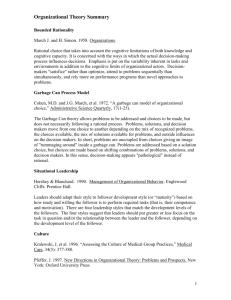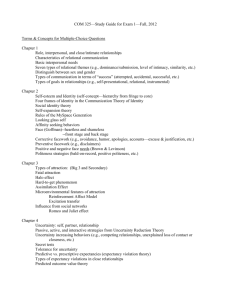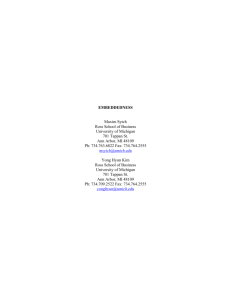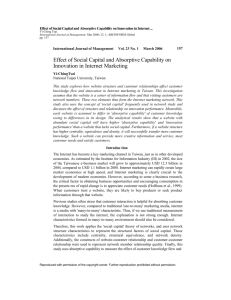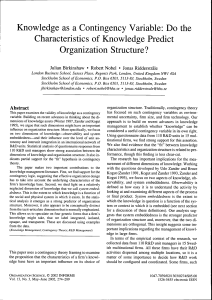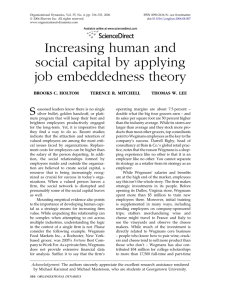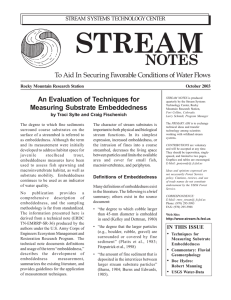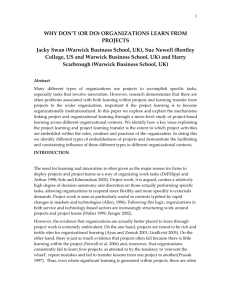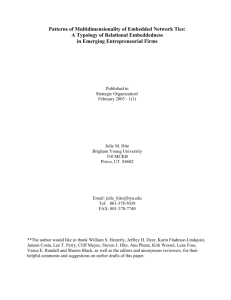Organizational Theory Comps_Summary_Table Form
advertisement
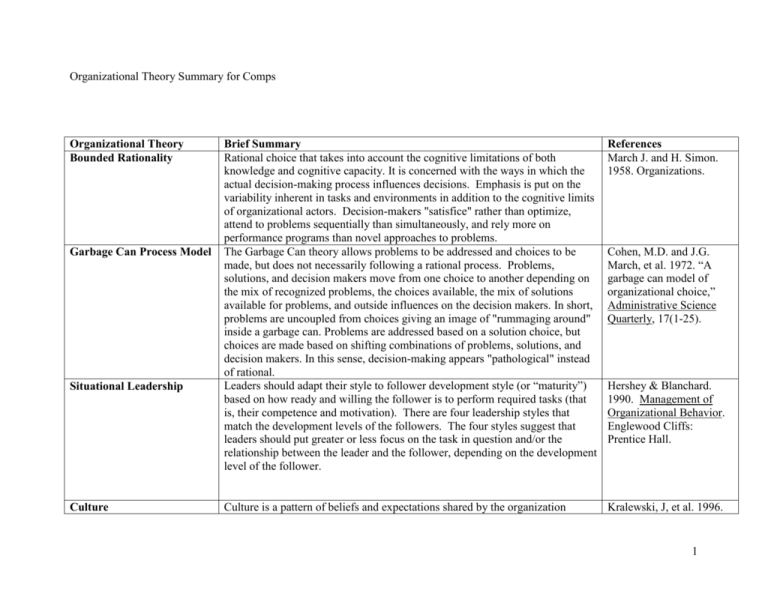
Organizational Theory Summary for Comps Organizational Theory Bounded Rationality Garbage Can Process Model Situational Leadership Culture Brief Summary Rational choice that takes into account the cognitive limitations of both knowledge and cognitive capacity. It is concerned with the ways in which the actual decision-making process influences decisions. Emphasis is put on the variability inherent in tasks and environments in addition to the cognitive limits of organizational actors. Decision-makers "satisfice" rather than optimize, attend to problems sequentially than simultaneously, and rely more on performance programs than novel approaches to problems. The Garbage Can theory allows problems to be addressed and choices to be made, but does not necessarily following a rational process. Problems, solutions, and decision makers move from one choice to another depending on the mix of recognized problems, the choices available, the mix of solutions available for problems, and outside influences on the decision makers. In short, problems are uncoupled from choices giving an image of "rummaging around" inside a garbage can. Problems are addressed based on a solution choice, but choices are made based on shifting combinations of problems, solutions, and decision makers. In this sense, decision-making appears "pathological" instead of rational. Leaders should adapt their style to follower development style (or “maturity”) based on how ready and willing the follower is to perform required tasks (that is, their competence and motivation). There are four leadership styles that match the development levels of the followers. The four styles suggest that leaders should put greater or less focus on the task in question and/or the relationship between the leader and the follower, depending on the development level of the follower. References March J. and H. Simon. 1958. Organizations. Culture is a pattern of beliefs and expectations shared by the organization Kralewski, J, et al. 1996. Cohen, M.D. and J.G. March, et al. 1972. “A garbage can model of organizational choice,” Administrative Science Quarterly, 17(1-25). Hershey & Blanchard. 1990. Management of Organizational Behavior. Englewood Cliffs: Prentice Hall. 1 Organizational Theory Brief Summary members. These beliefs and expectations produce norms that shape the behavior of both individuals and groups within an organization. Culture is usually long-term, strategic, and difficult to change. It is rooted in beliefs and values. An organizational culture also represents the shared sense of the way we do things around here, a critical factor in guiding day-to-day behavior and shaping a future course of action. Often more informal controls predominate in organizations, even when formal controls are present. Often these types of informal controls are defined as the corporate culture. References “Assessing the Culture of Medical Group Practices,” Medical Care, 34(5): 377-388. Social network theory views social relationships in terms of nodes and ties. Nodes are the individual actors within the networks, and ties are the relationships between the actors. In its most simple form, a social network is a map of all of the relevant ties between the nodes being studied. The network can also be used to determine the social capital of individual actors. These concepts are often displayed in a social network diagram, where nodes are the points and ties are the lines. Barbasi, A. 2003. Linked. Penguin Book. Embeddedness Theory Embeddedness theory acknowledges that "the on-going networks of social relations between people discourage malfeasance." People guide their choices based on past actions with people and continue to deal with those they trust. However, embeddedness theory makes no assumptions of an orderly selfregulating system, and acknowledges that social networks alone will not deter malfeasance. Granovetter, M. 1985. “Economic Action and Social Structure: The Problem of Embeddedness,” American Journal of Sociology, pp.53-81. Resource Dependency Theory Proposes that actors lacking in essential resources will seek to establish relationships with (i.e., be dependent upon) others in order to obtain needed Pfeffer, J. and G. Salancik. 1978. The External Social Network Theory Pfeffer, J. 1997. New Directions in Organizational Theory: Problems and Prospects. New York: Oxford University Press Coleman, J. 1990. “Social capital in the creation of human capital,” American Journal of Sociology, 94 supplement: 95s-120s. 2 Organizational Theory Systems Framework Brief Summary resources. Also, organizations attempt to alter their dependence relationships by minimizing their own dependence or by increasing the dependence of other organizations on them. Within this perspective, organizations are viewed as coalitions alerting their structure and patterns of behavior to acquire and maintain needed external resources. Acquiring the external resources needed by an organization comes by decreasing the organization’s dependence on others and/or by increasing other’s dependency on it, that is, modifying an organization’s power with other organizations. Consistent with institutional theories in which organizations are persistent structures of order under constant reinterpretation and negotiation, interacting with an (often turbulent) environment and subject to various competing interests and influences. Attention is focused on the whole organization, the relationships between its technical, mechanical or structural parameters and its behavioral, social or human elements, and its relationship with the business environment. It recognizes the presence of contingent environmental factors, which even though they may lie outside the organizational boundaries, nevertheless influence organizational activity. Contingency Theory *an outgrowth of systems design * there is no one best way to organize * any way of organizing is not equally effective *the best way to organize depends on the nature of the environment to which the organization relates There are also contingency theories that relate to decision making. According to these models, the effectiveness of a decision procedure depends upon a number of aspects of the situation: the importance of the decision quality and acceptance; the amount of relevant information possessed by the leader and subordinates; the likelihood that subordinates will accept an autocratic decision or cooperate in trying to make a good decision if allowed to participate; the amount of disagreement among subordinates with respect to their preferred alternatives. References Control of Organizations. New York: Harper and Row. Katz, D. and R. Kahn. 1978. Social Psychology of Organizations. New York: Wiley. Lawrence, P. and J.W. Lorsch. 1967. “Differentiation and integration in complex organization,” Administrative Science Quarterly, 12: 1-47. Schoonhoven, C.K. 1981. “Problems with contingency: Testing assumptions hidden within the language of contingency theory,” Administrative Science 3 Organizational Theory Brief Summary Institutional Theory It considers the processes by which structures, including schemas, rules, norms, and routines, become established as authoritative guidelines for social behavior. It inquires into how these elements are created, diffused, adopted, and adapted over space and time; and how they fall into decline and disuse. Although the ostensible subject is stability and order in social life, students of institutions must perforce attend not just to consensus and conformity but to conflict and change in social structures. References Quarterly, 26: 349-377. DiMaggio, P. and W. Powell. 1983. “The iron cage revisited: Institutional isomorphism and collective rationality in organization fields,” American Sociological Review. Meyer, J. and B. Rowan. 1977. “Institutionalized organizations: Formal structure as myth and ceremony,” American Journal of Sociology. Agency Theory Transaction Costs Their primary focus is the situation where one party (the principal) seeks some outcome but requires the assistance of an agent to carry out the necessary activities (e.g, supervisor-subordinate). Agents usually know more about the tasks than the principals (information assymetry). Principals seek to gain information (by inspection or evaluation), develop incentive systems to ensure agent actions in the principal's interests. Agency theorists attempt to design the most cost effective information systems. Agency theory states that we need organizations to help monitor and give incentives to agents doing coordinated, cooperative work. When ownership is concentrated in one principal, then contracts are needed to define obligations and incentives, especially those in the periphery of the organization. As exchanges become more complex and uncertain (unstable environment, unscrupulous traders), various kinds of external and internal controls are needed to help reduce the risk (i.e., transaction cost) of exchanges. "Organizational Pfeffer, J. 1997. New Directions in Organizational Theory: Problems and Prospects. New York: Oxford University Press Pfeffer, J. 1997. New Directions in Organizational Theory: 4 Organizational Theory Information processing model Brief Summary structures are viewed as one important arrangement for establishing and safeguarding transactions." Transaction cost economics suggests that the costs and difficulties associated with market transactions sometimes favor hierarchies (or in-house production) and sometimes markets as an economic governance structure. An intermediate mechanism, called hybrid or relational, between these two extremes has recently emerged as a new governance structure. This theory identifies three important concepts: information processing needs, information processing capability, and the fit between the two to obtain optimal performance. Organizations need quality information to cope with environmental uncertainty and improve their decision making. Environmental uncertainty stems from the complexity of the environment and dynamism, or the frequency of changes to various environmental variables. Typically, organizations have two strategies to cope with uncertainty and increased information needs: (1) develop buffers to reduce the effect of uncertainty, and (2) implement structural mechanisms and information processing capability to enhance the information flow and thereby reduce uncertainty. References Problems and Prospects. New York: Oxford University Press Galbraith, J.R. 1972. “Organization design: An information processing view.” In J.W. Lorsch & P.R. Lawrence (eds.). Organization Planning: Cases and Concepts: 4974. Homewood, IL: Richard D. Irwin, Inc. Tushman, M. & Nadler, D. 1978. “Information processing as an integrating concept in organizational design,” Academy of Management Review, 3(3): 613-624. Relational Coordination Argues that the coordination of highly interdependent work is more effectively carried out through high-quality communication and relationships, particularly through relationships of shared goals, shared knowledge, and mutual respect. Coordination is not a mechanistic process, but rather a relational one. Highquality communication and relationships together give rise to high-quality connections – connections that are life giving rather than life depleting. Gittell, J.H. 2003. “A theory of relational coordination,” in Positive Organizational Scholarship: Foundations of a New Discipline, eds. K.S. Cameron, J.E. Dutton & R.E. Quinn, San 5 Organizational Theory Brief Summary References Francisco: Berrett-Koehler Publishing. Networks in Organizations One goal of the organization design is to have a balance between the technical, political and cultural domains. Technical: task (outputs), information processing of a network; how well organizations do their goals – produce outputs efficiently and effectively Political: resources and power; networks are relevant for building coalitions, greater capacity for bargaining and conflict resolution Cultural: values, beliefs and norms and how they are transmitted; relevant networks because it’s a way of transmitting/diffusing values of the organization Networks are relevant in each of these domains. A more organic organization would have a greater capacity for all of these domains; a mechanistic organization would have less. Tichy, N.M. 1981. "Networks in organizations.” In P.C. Nystrom & W. Starbuck (eds.), Handbook of Organizational Design. New York: Oxford University Press. Intellectual capital Refers to the knowledge and knowing capability of a social collectivity, such as an organization, intellectual community, or professional practice. It represents a valuable resource and a capability for action based in knowledge and knowing. Organizations make knowledge tacit to explicit once they know something works. It helps save time and is easy to replicate. It parallels human capital, which embraces acquired knowledge skills and capabilities that enable people to act in new ways. It has 4 elements: 1. individual explicit knowledge 2. individual tacit knowledge 3. social explicit knowledge 4. social tacit knowledge Powell, W. 1990. "Neither market nor hierarchy: Network forms of organization," Research in Organizational Behavior, 12:295-336. Nahapiet, J. & Ghoshal, S. 1998. “Social capital, intellectual capital and the organizational advantage,” Academy of Management Review, 232: 242-266. 6
